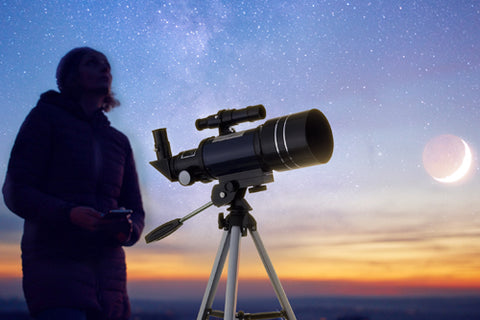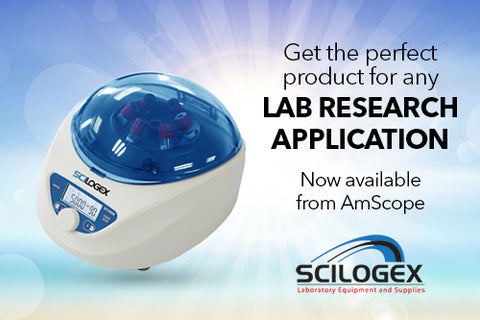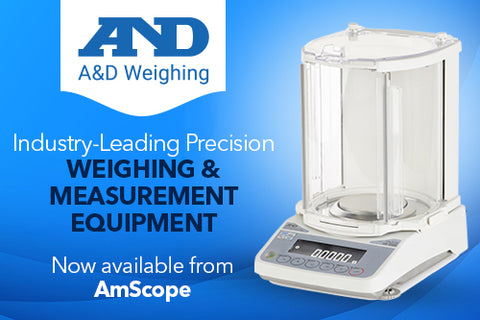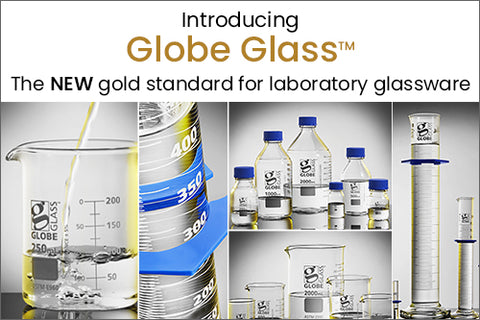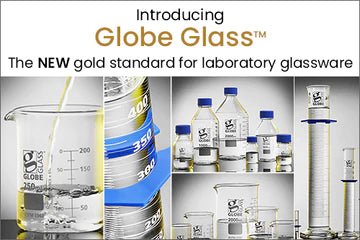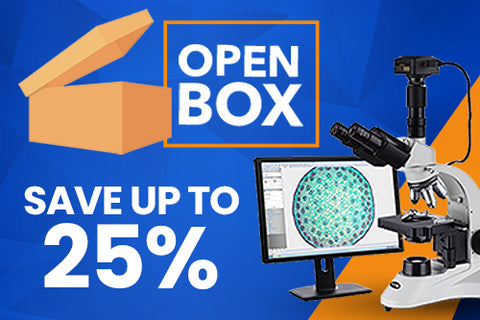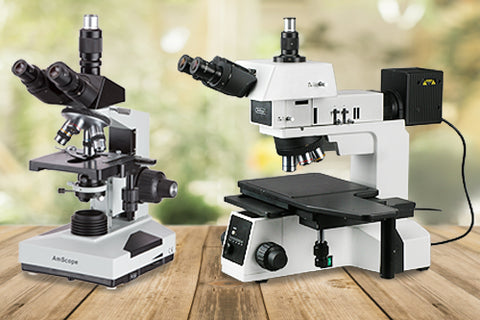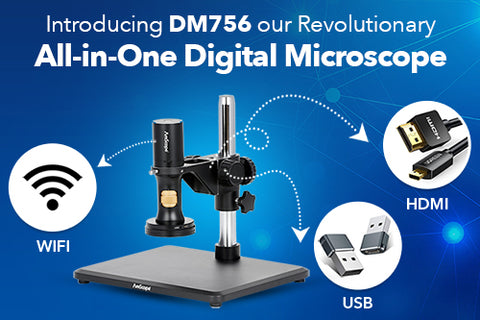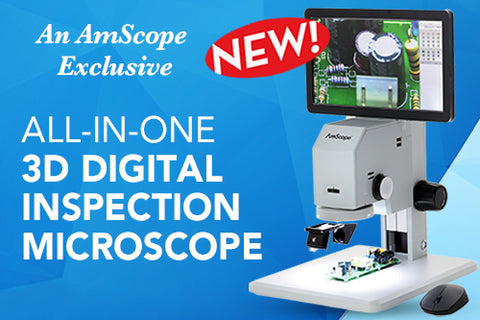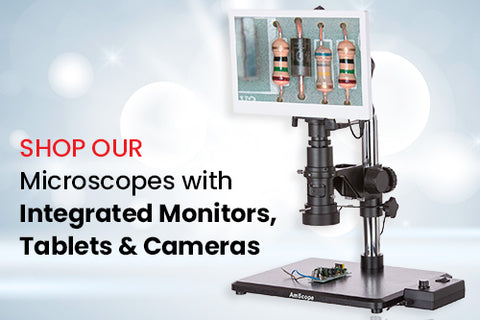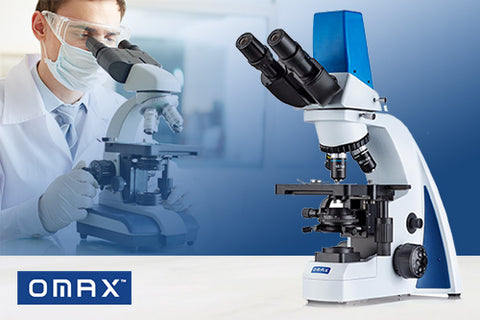AmScope MU Series 0.4MP USB 3.0 Monochrome Global-Shutter CMOS C-Mount Microscope Camera with Reduction Lens
Key Features
- An ultra-sensitive monochrome camera for low-light applications including fluorescence.
- 7469mV sensitivity provides up to 520fps for extreme responsiveness.
- Global-shutter sensor captures fast-moving subjects without the distortion seen in conventional sensors
- Professional photomicrography software is included.
- Includes calibration slide for on-screen measurements
Low-light Specialist
The MU043M-FL is designed specifically for extreme low-light applications. The cutting-edge global-shutter sensor takes quantum conversion to a whole new level. The monochrome sensor was designed for challenging tasks including deep-space imaging, so it's no surprise it provides an astonishing 7469mV photoelectric-conversion (1/30s, f/5.6). Not only that, but due to the lower resolution and increased sensitivity, maximum framerates up to 520fps can be achieved for incredibly responsive real-time previews*. All of this adds up to a camera born for fluorescence and dark-field applications, as well as applications involving photosensitive subjects. Due to the extreme sensitivity, this camera is not intended for high-output brightfield illumination.
*Preview framerate may not match the recorded framerate. Extreme framerates are dependent on the computer's processing power and recording media.
Sensitivity
An image sensor's sensitivity is one of the most important characteristics for low-light imaging. The ability to efficiently capture light with low noise levels allows the capture of faint signals, or to capture vivid images very quickly. The study of live specimens or other light-sensitive subjects can be difficult due to the amount of light needed to produce an image. One of the result is specimen bleaching, which shortens the subjects lifetime and limits the time available to study it. A highly sensitive sensor can reduce the amount of exposure, prolonging the viability of the specimen.
 |
The sensor's sensitivity is measured by the amount of photonic energy it is able to convert into electric potential during exposure. Using a standard of 1/30th of a second, this sensor can produce up to 7469mV measured with a lens with f/5.6 aperture. Higher efficiency in light-gathering and conversion means that less light is needed to produce a viable image. |
Monochrome vs Color
Monochrome may seem antiquated in modern imaging, but it still holds relevance. All sensors are fundamentally monochrome, as a silicon substrate does not interpret color. Most color sensors use an array of red, green, and blue filters arranged in a Bayer pattern to filter out all but the intended wavelengths of light. The image is later demosaiced to produce a full-color image with each pixel borrowing color data from its neighbors. The resulting image can be extremely accurate depending on the demosaicing algorithm used.
The downside of using a Bayer (or other) filter array is that a lot of light is rejected at each pixel, resulting in longer exposures needed to achieve full well-capacity. If light is abundant, this is not much of a problem. But for low-light applications, every drop of light counts. Monochrome sensors do not use color filters, so they can capture more light per pixel in shorter durations.
Global Shutter Technology
One of the major benefits of CMOS technology in imaging sensors is the ability to read each pixel independently. This drastically cuts down the time required to capture an image, and reduces noise compared to CCD readout methods. The line-by-line "rolling shutter" readout method reads some lines of pixels while others are in the process of capturing, leading to distortion in subjects in motion, mostly noticeable in high-speed motion.
Global shutter to the rescue. Global shutter is a method of capturing and reading out an image which in some ways mimics CCD technology. The entire image is read out at the same time, avoiding potential continuity errors seen with rolling shutter. This is beneficial for capturing objects in motion, and produces a more accurate image.
Field of View
Using a 1/3-inch format sensor, this camera is best-used with a 1/3X reduction lens or 1/3X C-mount photo-ports. A 0.37X reduction lens for 23mm ports is included, along with 30mm and 30.5mm adapters. This maximizes the field-of-view captured by the camera.
Software
With software available for Windows, Mac, and Linux, this camera package is a multi-platform imaging solution. The included Windows software offers image-development and measurement tools, as well as advanced compositing features such as image-stitching and extended-depth-of-focus. A measurement calibration slide is included to properly calibrate the software's scale for use with the array of linear and geometric measurement tools. With the ability to calibrate scales at multiple magnifications, the software can be used for multi-level inspection. Independent preview and capture resolutions allow you to view high-speed video while simultaneously capturing high-definition images. For Mac and Linux, there is a lite version of the software which can capture video and still images, and includes limited processing features.
Specifications
| Sensor Specifications | |
| Model | IMX287 (monochrome) |
| Sensor Type | CMOS |
| Sensor Optical Format | 1/3" |
| Active Pixels | 0.39M (720 x 540) |
| Pixel Size | 6.9µm x 6.9µm |
| Active Sensor Area | 4.97mm x 3.73mm |
| Shutter | global shutter |
| Sensitivity | 7469mV (f5.6) @ 1/30s 3660mV (f8) @1/30s |
| Spectral Response | 380-650nm with IR-cut filter |
| Other Camera Specifications | |
| Video Capture Resolution | 720 x 540 |
| Video Framerate | 520fps maximum* |
| *Maximum preview framerate may exceed capture framerate. Extreme framerates are dependent on the computer's processing power and recording media. | |
| Photo Capture Resolution | 1920 x 1080 |
| Connectivity | USB 3.0 |
| Lens-mount | C-mount |
| Compensating Lens | 0.37X |
| Power | 5VDC over USB |
| Operating Temperature | -10-50°C |
| Operating Humidity | 30-80% |
Software
| OS Requirements | Windows (32/64 bit) XP/Vista/7/8/10, Mac OS 10.8+, Linux kernel 3.13+ | ||||||||||||||||||
|---|---|---|---|---|---|---|---|---|---|---|---|---|---|---|---|---|---|---|---|
| Hardware Requirements | Intel Core2 2.8GHz or comparable processor, 4GB RAM | ||||||||||||||||||
| Features |
|
Contents:
| application | Camera-Brightfield, Camera-Darkfield, Camera-Fluorescence |
| camera application | PC & Mac Display |
| camera connectivity | USB 3.0 |
| camera mounting size | C-Mount |
| camera reduction lens | 0.3X |
| camera sensor | CMOS |
| camera type | Brightfield, Darkfield, Fluorescence |
| compatibility | PC & Mac |
| Manufacturer | AmScope |
| mounting size | Camera-C-Mount |
| product condition | NEW |
| product contents |
Packing List: |
| prop 65 |

|
| sensor | Camera-CMOS |
AmScope products are warranted against manufacturer’s defects in material and workmanship from the original date of purchase, for the following years:
• Five Year Warranty for Microscopes: All our microscopes come with a five (5) year factory warranty against manufacturing defects, covering labor and parts.
• Ten Year Warranty for Euromex Microscopes: All our Euromex microscopes come with a ten (10) year factory warranty against manufacturing defects, covering labor and parts.
• One Year Warranty for Telescopes: All our telescopes come with a one (1) year warranty, except when specified in the description.
• One Year Warranty for Accessories: All our microscope accessories (USB cameras, illuminators, illumination, dust covers, and etc.) come with a one (1) year warranty, except when specified in the description.
• One Year Warranty for Items labeled as “Product Ships From Manufacturer”: All products that are shipped directly from the manufacturer come with a one (1) year warranty, except when specified in the description.
Warranty does not apply for consumable accessories and parts such as bulbs, batteries, fuses, cords, optical components or any add-on accessories such as mechanical specimen holders that are not built into the microscope stage as an integral part of the original manufacture, etc. Warranty does not cover microscopes, lenses cameras or other accessories that have become inoperable due to dirt or damage due to misuse or lack of maintenance.
Note: Buyers are responsible for return shipping and handling cost for warranty services. Our warranty covers parts and labor only.
Low-light Specialist
The MU043M-FL is designed specifically for extreme low-light applications. The cutting-edge global-shutter sensor takes quantum conversion to a whole new level. The monochrome sensor was designed for challenging tasks including deep-space imaging, so it's no surprise it provides an astonishing 7469mV photoelectric-conversion (1/30s, f/5.6). Not only that, but due to the lower resolution and increased sensitivity, maximum framerates up to 520fps can be achieved for incredibly responsive real-time previews*. All of this adds up to a camera born for fluorescence and dark-field applications, as well as applications involving photosensitive subjects. Due to the extreme sensitivity, this camera is not intended for high-output brightfield illumination.
*Preview framerate may not match the recorded framerate. Extreme framerates are dependent on the computer's processing power and recording media.
Sensitivity
An image sensor's sensitivity is one of the most important characteristics for low-light imaging. The ability to efficiently capture light with low noise levels allows the capture of faint signals, or to capture vivid images very quickly. The study of live specimens or other light-sensitive subjects can be difficult due to the amount of light needed to produce an image. One of the result is specimen bleaching, which shortens the subjects lifetime and limits the time available to study it. A highly sensitive sensor can reduce the amount of exposure, prolonging the viability of the specimen.
 |
The sensor's sensitivity is measured by the amount of photonic energy it is able to convert into electric potential during exposure. Using a standard of 1/30th of a second, this sensor can produce up to 7469mV measured with a lens with f/5.6 aperture. Higher efficiency in light-gathering and conversion means that less light is needed to produce a viable image. |
Monochrome vs Color
Monochrome may seem antiquated in modern imaging, but it still holds relevance. All sensors are fundamentally monochrome, as a silicon substrate does not interpret color. Most color sensors use an array of red, green, and blue filters arranged in a Bayer pattern to filter out all but the intended wavelengths of light. The image is later demosaiced to produce a full-color image with each pixel borrowing color data from its neighbors. The resulting image can be extremely accurate depending on the demosaicing algorithm used.
The downside of using a Bayer (or other) filter array is that a lot of light is rejected at each pixel, resulting in longer exposures needed to achieve full well-capacity. If light is abundant, this is not much of a problem. But for low-light applications, every drop of light counts. Monochrome sensors do not use color filters, so they can capture more light per pixel in shorter durations.
Global Shutter Technology
One of the major benefits of CMOS technology in imaging sensors is the ability to read each pixel independently. This drastically cuts down the time required to capture an image, and reduces noise compared to CCD readout methods. The line-by-line "rolling shutter" readout method reads some lines of pixels while others are in the process of capturing, leading to distortion in subjects in motion, mostly noticeable in high-speed motion.
Global shutter to the rescue. Global shutter is a method of capturing and reading out an image which in some ways mimics CCD technology. The entire image is read out at the same time, avoiding potential continuity errors seen with rolling shutter. This is beneficial for capturing objects in motion, and produces a more accurate image.
Field of View
Using a 1/3-inch format sensor, this camera is best-used with a 1/3X reduction lens or 1/3X C-mount photo-ports. A 0.37X reduction lens for 23mm ports is included, along with 30mm and 30.5mm adapters. This maximizes the field-of-view captured by the camera.
Software
With software available for Windows, Mac, and Linux, this camera package is a multi-platform imaging solution. The included Windows software offers image-development and measurement tools, as well as advanced compositing features such as image-stitching and extended-depth-of-focus. A measurement calibration slide is included to properly calibrate the software's scale for use with the array of linear and geometric measurement tools. With the ability to calibrate scales at multiple magnifications, the software can be used for multi-level inspection. Independent preview and capture resolutions allow you to view high-speed video while simultaneously capturing high-definition images. For Mac and Linux, there is a lite version of the software which can capture video and still images, and includes limited processing features.
Specifications
| Sensor Specifications | |
| Model | IMX287 (monochrome) |
| Sensor Type | CMOS |
| Sensor Optical Format | 1/3" |
| Active Pixels | 0.39M (720 x 540) |
| Pixel Size | 6.9µm x 6.9µm |
| Active Sensor Area | 4.97mm x 3.73mm |
| Shutter | global shutter |
| Sensitivity | 7469mV (f5.6) @ 1/30s 3660mV (f8) @1/30s |
| Spectral Response | 380-650nm with IR-cut filter |
| Other Camera Specifications | |
| Video Capture Resolution | 720 x 540 |
| Video Framerate | 520fps maximum* |
| *Maximum preview framerate may exceed capture framerate. Extreme framerates are dependent on the computer's processing power and recording media. | |
| Photo Capture Resolution | 1920 x 1080 |
| Connectivity | USB 3.0 |
| Lens-mount | C-mount |
| Compensating Lens | 0.37X |
| Power | 5VDC over USB |
| Operating Temperature | -10-50°C |
| Operating Humidity | 30-80% |
Software
| OS Requirements | Windows (32/64 bit) XP/Vista/7/8/10, Mac OS 10.8+, Linux kernel 3.13+ | ||||||||||||||||||
|---|---|---|---|---|---|---|---|---|---|---|---|---|---|---|---|---|---|---|---|
| Hardware Requirements | Intel Core2 2.8GHz or comparable processor, 4GB RAM | ||||||||||||||||||
| Features |
|
Contents:






